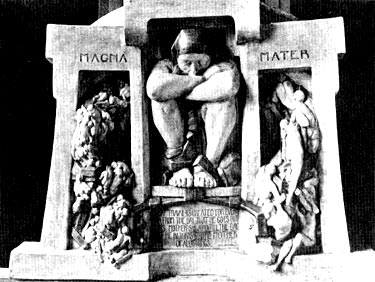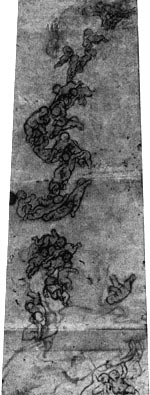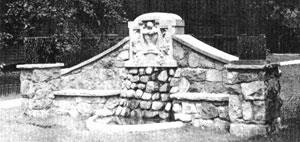John & Katharine Maltwood Collection
| View the Collection |
History of the Collection |
John & Katharine Maltwood |
Information Resources |
The Maltwoods Introduction
Katharine Maltwood Biography
Early Sculpture
- Education - Magna Mater - London Salon (1912) - Primeval Canada - A Vision - Contemporary Style - Eric Gill Post-War Works Glastonbury Zodiac Life in Victoria, B.C. Monograph (pdf 1.14 MB)
About Us Contact Us Visit Us Site Map

Early Sculpture - Part 2: Magna Mater | ||||||
|
Katharine Maltwood's first major work, entitled Magna Mater, was a large high-relief sculpture carved in Portland Stone. It was accepted for exhibition by the Royal Academy in 1911. Again a text accompanies the piece: "Great travail is created for every man from the day he goes out of his mother's womb till the day he returns to the Mother of all things." The central Blake-like figure typifies nature, crouched and bound, contemplating the mass of humanity struggling out and in on either side.
The figures are enclosed in a temple-like frame which critics found reminiscent of Archaic or Egyptian architecture. To some the archaism of the relief proved Katharine Maltwood's sympathy with the modern Viennese school of sculpture. While others found a similarity in style to the contemporary English sculptors Eric Gill and Jacob Epstein in its expressive vigour and strength.23 The work is a good example of the new pragmatic approach to sculpture, stressing architectonic forms and an honest expression of the nature of the medium. It was very well received by the critics and in the Sunday Times, 30 April 1911, was named "the most impressive sculptural exhibit" due to its "truly monumental quality."
An interesting report appears in an unnamed clipping from 28 July, 1911 to which Katharine Maltwood added the title "Votes for Women". The article praises Magna Mater as a work expressing the elemental truth of motherhood not in the ordinary individual sense but in the larger universal sense. It urges that all supporters of the Women's movement "pay homage" to the artist's "poem in stone" and concludes: "But are women really sitting at the feet of man waiting to applaud their poem. Are they not rather making their own poems, using their own god-like gifts of Creation in many ways? Not as Mothers only, but as Makers, women are coming into their own." This reveals something of Katharine Maltwood's sympathies with the Women's movement and how she viewed herself as a serious creative artist. Magna Mater was commissioned by Elbert Hubbard, one of the key figures in the American Arts and Crafts Movement in the early 1900's. Hubbard, who had amassed a modest fortune managing a soap company in Chicago, visited England in the 1880's where he met William Morris. Inspired by the latter's work and ideals he returned to East Aurora, New York, to found the Roycroft Institute which became a thriving craft-orientated community. As a public taste-maker he crusaded for studied simplicity and arts and crafts in the American home. In addition to hand-made items in copper and leather, furniture and other artifacts, Elbert Hubbard's philosophical writings were produced in the Roycrofters print shop and bindery and achieved a vast circulation. As an opinion-moulder Hubbard enthusiastically supported such things as education through manual crafts, feminism and women's rights, liberal divorce laws, yoga, health foods, and pantheism. Flamboyant in dress and manner, he practised a health and salvation gospel of his own and became a cultural messiah to thousands across the country.
The views of Hubbard's wife, Alice, also suggest Magna Mater was intended to embody the ideals of the women's movement. A friend and correspondent of Katharine Maltwood's, she was dedicated to women's emancipation more whole heartedly than her husband. She wrote: "The new woman will be free. Then she will be whatever her judgement wants her to be." She called for each woman to "come out from the ranks of paupers, dependents, children, and affirm her womanhood..."24 In letters to the English sculptress she praises Magna Mater in emotional tones: "I have paid the tribute of tears to your Magna Mater - I know, yes, I know what it means. It hushes me into silence and I bow my head to the Truth it expresses, the truth I experience." On another occasion she described the work's "abiding place" as follows: "We have cemented Her there among the stones and time cannot move her, nor man. She is our Shrine. She is part of us."25 That the Hubbards chose Katharine Maltwood to provide the Roycroft Shops with the visual inspiration of a work embodying their ideals is testimony to her being seen as a leading exponent of the Arts and Crafts Movement.
All content on this page is copyright © 30 January, 2006 |
||||||


